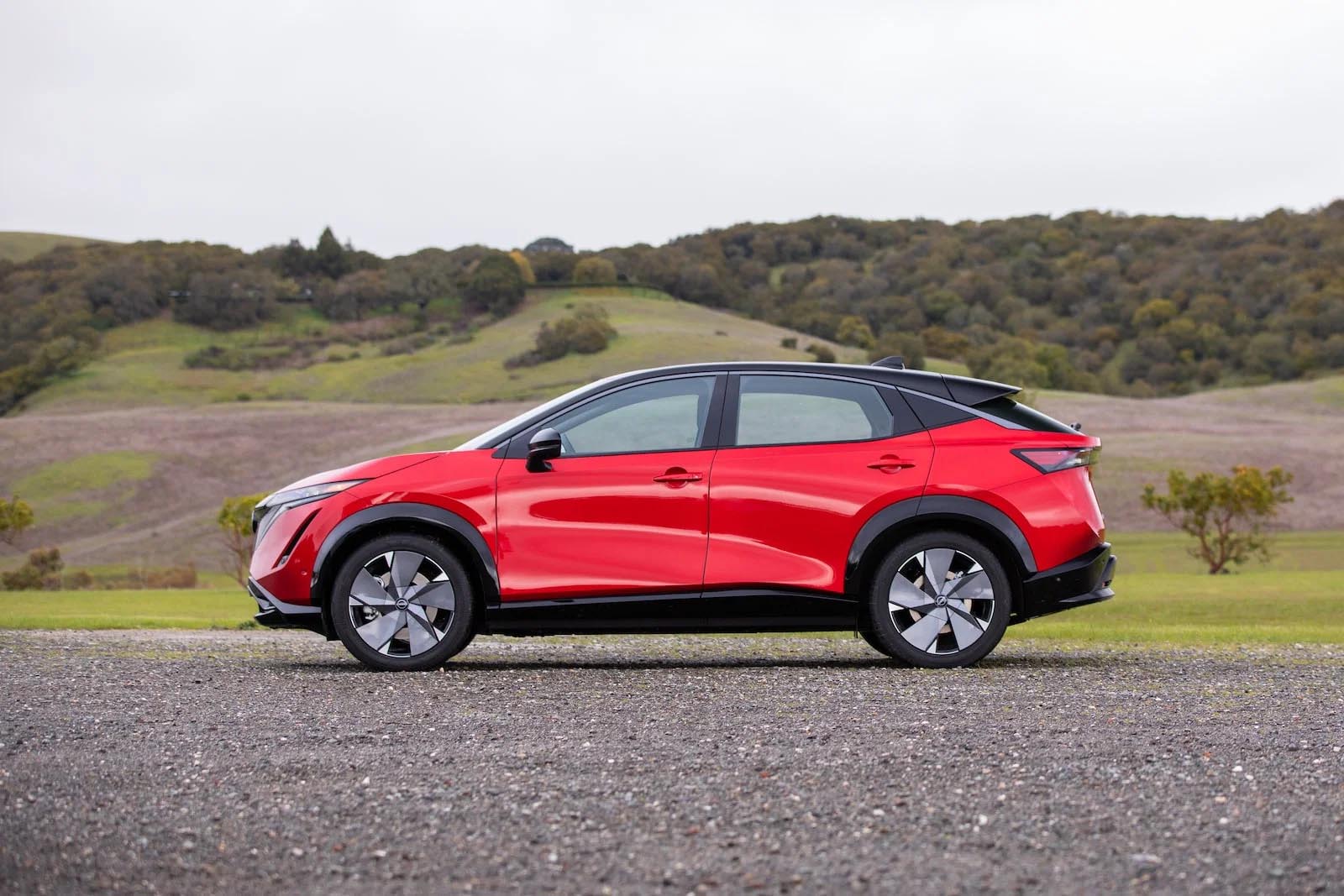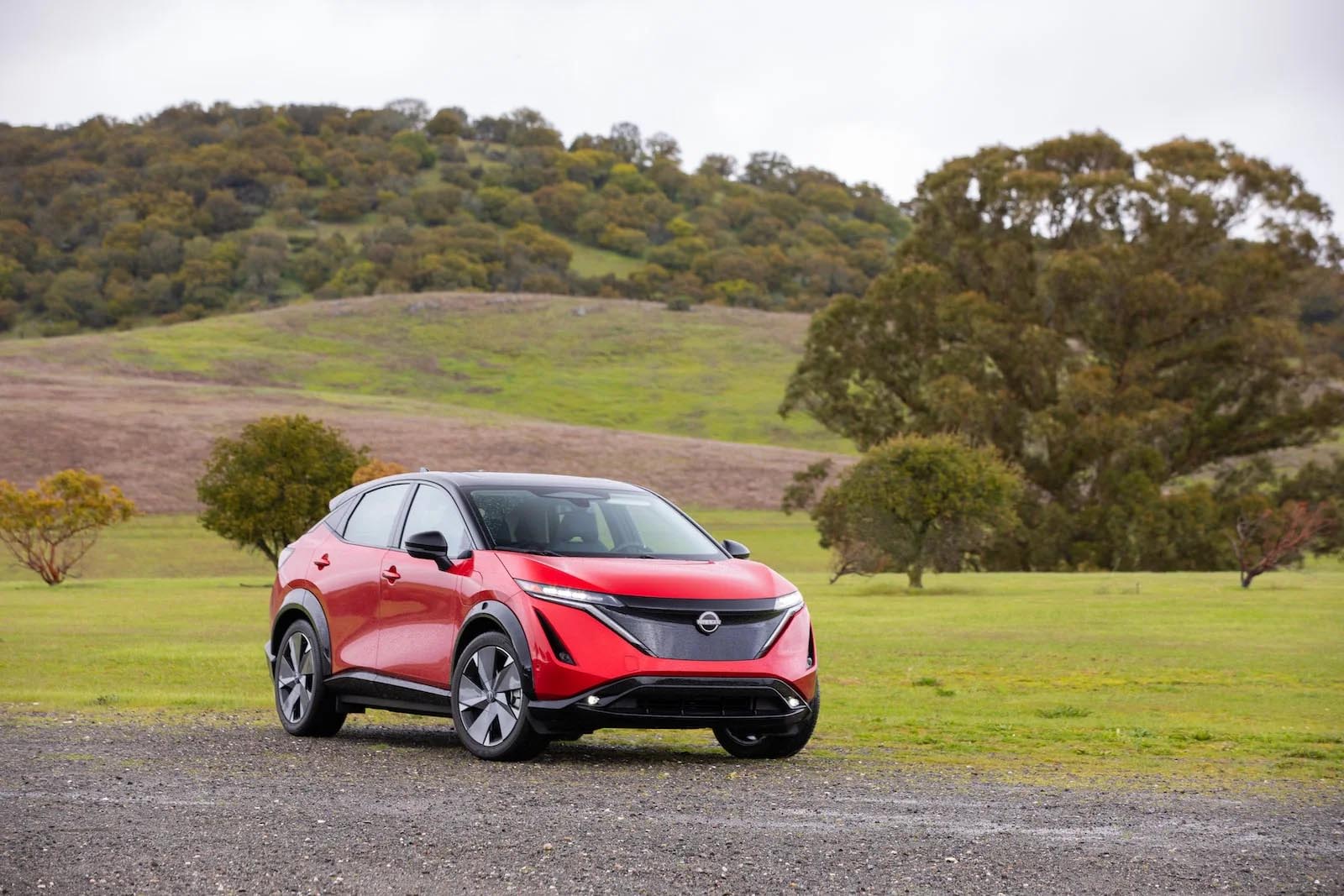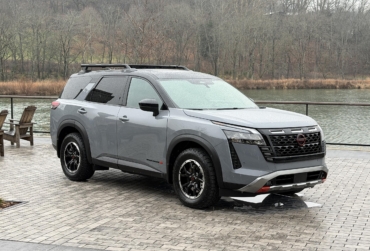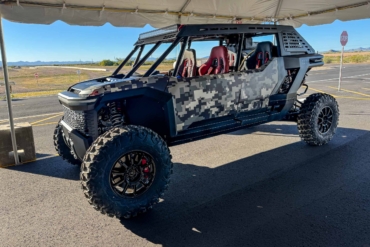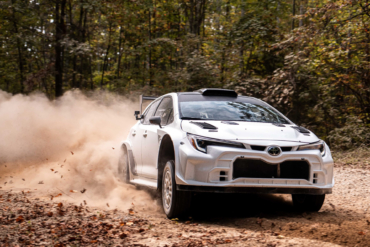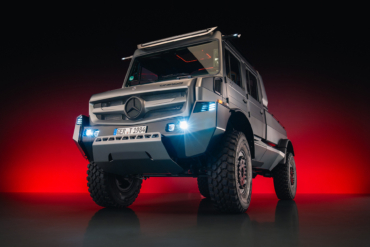Nissan was a pioneer in the emerging battery-electric vehicle market. Make it the pioneer, with the original Nissan Leaf on sale in late 2010 as the first mass-market EV, well ahead of competitors like Ford, General Motors, Volkswagen, or, of course, Tesla. But, as more and more alternatives have come to market, the Leaf has become little more than an afterthought, the bargain option for those absolutely committed to switching to battery power on a budget.
The second largest of the Japanese automakers, Nissan, has long promised to expand its EV lineup but, for a variety of reasons, only launched its second all-electric model during the second half of 2022. The initial front-wheel-drive Nissan Ariya is an attractive and reasonably well-equipped crossover-utility vehicle. But for those looking for better performance and handling, it’s the second version of the CUV, the 2023 Nissan Ariya e-4ORCE, that should be the object of their attention.
In short: Those interested in the 2023 Nissan Ariya now have two versions of the all-electric crossover to consider. For those who want better performance and handling and more features, the obvious choice is to upgrade to the all-wheel-drive version of the CUV, the 2023 Nissan Ariya e-4ORCE.
- Engine: Dual Externally Excited Synchronous, one per axle
- Battery: 91.4 kWh lithium-ion pack
- Drive: AWD
- HP/Torque: 389/ 442
- Range: 272 mi.
- Cargo: 22.8 cu. ft.; 59.7 cu. ft. max
- Towing: 1,500 lbs.
Pros
- Strong design
- Large interior
- Impressive performance
- Sporty e-4ORCE AWD
Cons
- Lack of frunk
- Not eligible for EV tax credits
- No 1-Pedal mode
Nissan Ariya: New Entry at Last
Last year brought roughly 50 new battery-electric vehicles to market. That included the all-new Nissan Ariya — which is pronounced like an operatic aria. It’s a much-needed — and woefully belated — entry from Japan’s second-largest automaker. Nissan was the pioneer of the battery-electric space, its original Leaf rolling out for the 2011 model year. At the time, company officials promised to bring an assortment of new EVs to market in short order. Instead, it waited more than a decade to finally follow through.
The good news is that the Nissan Ariya is a good-looking, roomy, and well-equipped entry into the emerging EV market. Now, it’s made even better with the addition of the Ariya e-4ORCE. Think of e-4ORCE as a “through-the-road” all-wheel-drive system.
There’s no mechanical link between the front and rear axles, each getting a standalone electric motor. The system not only improves grip on low-traction surfaces but also provides torque vectoring, a way of distributing torque to help power your way through tight corners.
That’s all the more useful with the comparatively anemic FWD model making 188 fewer ponies and half the torque.
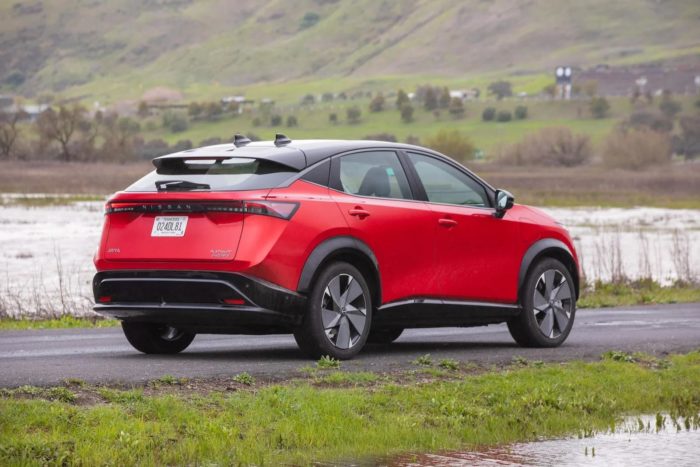
Different by Design
The EV’s shape doesn’t stray far from the Ariya concept that made its first public appearance at the 2019 Tokyo Motor Show. While it’s taken longer than expected to get it into production, the look hasn’t aged.
As with virtually every other EV now on the market, designers put an emphasis on range-extending aerodynamics. You can see that in the turbine blade-style wheels, the aggressive curve of the roofline, and the built-in spoiler. With no engine under the hood, meanwhile, there’s a sealed panel replacing a conventional grille.
But Ariya doesn’t go to the stylistic excesses of the Leaf. While distinctive, with what Nissan describes as a design influenced by “Japanese futurism,” Ariya adopts a much more practical SUV shape. That includes high-tech details such as its multi-LED headlamp system. Unlike many new EVs, Ariya skips the now-clichéd use of a front lightbar, though the brand’s logo is backlit.
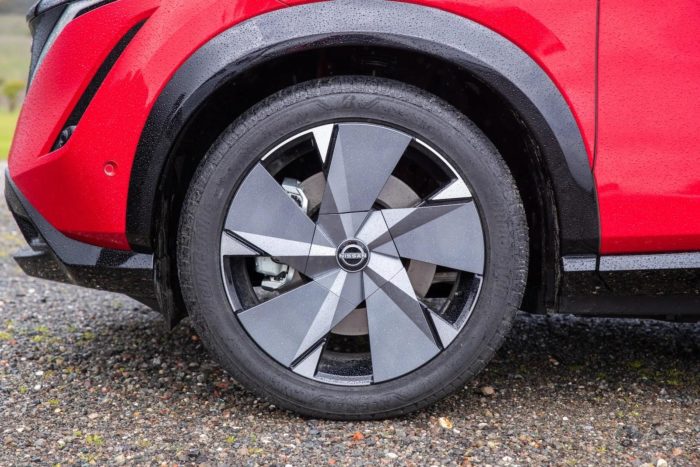
Plenty of Interior Space
Ariya is based on a unique, EV-only “architecture” mounting key powertrain components, including the battery pack, below the load floor. With no engine under the hood, Nissan’s product development team opted for an extremely cab-forward shape. There’s no frunk under the hood, but the layout translates into an extremely roomy interior.
Consider that the new EV is barely as long as the familiar, compact Nissan Rogue SUV. But the wheelbase has been stretched by 2.8 inches, helping yield interior space roughly equal to that of the Nissan Murano. And the EV has 2 inches more headroom.
Cargo space, meanwhile, is as much as 59 cubic feet with the rear seat down.
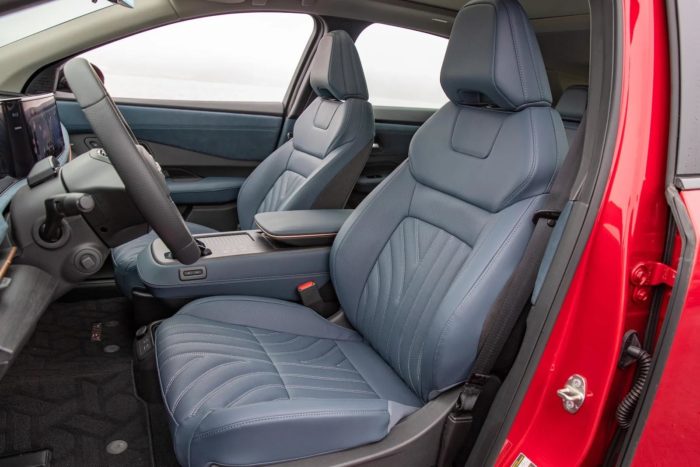
Ariya’s Futuristic Interior
The “Japanese Futurism” theme carries over into the interior, starting with the twin 12.3-inch displays and a 10-inch head-up display — all reconfigurable. Ariya also makes good use of ambient lighting, notably with the “Kumiko Lantern,” influenced by traditional Japanese design, on the lower half of the instrument panel.
The flat load floor lends to the element of spaciousness, and there are plenty of storage nooks. This includes a roomy center console that also is power operated, letting it slide fore and aft.
A distinctive sliding gearshift sits atop the console, as do a handful of capacitive touch switches that operate various vehicle functions, including Driving Mode and the level of Ariya’s regenerative braking. That brings to mind two complaints.
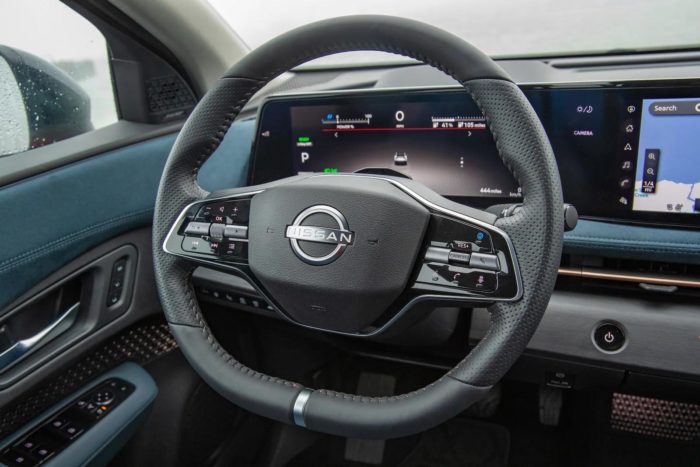
Some Shortfalls
First, like so many new products, gas or electric, Nissan has moved most vehicle functions to the infotainment screen. Even for someone as tech-savvy as I consider myself to be, Nissan needs to step back. Some functions, such as the seat and steering wheel heaters, need to have conventional, standalone switches and knobs.
The other concern is Ariya’s lack of a 1-Pedal mode. All EVs use regenerative braking to recapture energy normally lost during braking and coasting to extend range. You can increase the level of “regen” by activating the crossover’s “e-Step” feature.
But it doesn’t go far enough. Full 1-Pedal mode would let you do much of your normal driving simply by modulating the throttle, allowing you to seldom jump back and forth from throttle to brake, whether in traffic or out for a fun ride through twisty back roads.
Ariya e-4ORCE Powertrain
That’s too bad because the 2023 Nissan Ariya e-4ORCE is, on the whole, a fun vehicle to take out on the road. As earlier noted, its twin electric motors produce a combined 389 horsepower and 442 pound-feet of torque. That’s up from 238 ponies and 221 pound-feet with the FWD model and cuts 0-60 mph launches down from 7.2 to a factory-estimated 4.8 seconds. You won’t beat the fastest versions of the Tesla Model Y or Ford Mustang Mach-E GT with the performance pack, but with its burst of instant torque, the Nissan EV is certain to put a smile on your face.
And the e-4ORCE technology adds to the fun. Like any AWD system, it’s designed to move torque to where it’s best needed on slippery roads. With e-4ORCE, Ariya also can torque vector, the system gently applying the brakes on the inner wheels when you’re carving through a tight corner to improve handling.
2023 Nissan Ariya e-4ORCE: Driving Impressions
While it’s not the fastest EV crossover off the line, I found Ariya plenty of fun to drive during a day wandering through Sonoma and Napa wine country, where there were plenty of winding country roads to put Nissan’s electric crossover to the test.
Steering was precise and predictable and offered a fair amount of road feedback, with Ariya’s suspension allowing only moderate body roll in aggressive turns. On rough roads, it was good at soaking up bumps, as well.
If you’re more into long cruises, Nissan engineers have provided acoustic laminated glass and plenty of insulation to soak up wind and road noise. At the other extreme, an active sound generator provides aural feedback when in Sport mode to give a driver a sense of how they’re accelerating.
Ariya is offered with a variety of advanced driver assistance systems, including Nissan’s latest ProPilot Assist 2.0, which lets you go fully hands-free on divided, interstate-class highways. You do need to keep your eyes focused on the road, however, and be ready to retake control quickly.
Range and Charging
As you’d expect, adding a second motor and plenty of additional torque and horsepower does carry a penalty. But the 2023 Nissan Ariya e-4ORCE sacrifices just 32 miles of range compared to the original FWD package — at an EPA-estimated 272 miles per charge. That’s with the extended battery pack I expect most buyers will opt for. Even with the standard-range pack, Ariya e-4ORCE yields 205 miles, not much less than a comparable Toyota bZ4X with its biggest pack.
Charging isn’t as quick as the Hyundai Ioniq 5 or Kia EV6, both sharing a unique 400/800V electrical architecture. Even then, you can go from 10% or 80% of maximum charge with either Ariya in about 35 minutes using a public DC quick charger capable of delivering at least 130 kilowatts. That’s more or less the norm for the latest public chargers. You’ll need to stay plugged in overnight using a 240V home charger — though that will get you to a 100% state of charge.
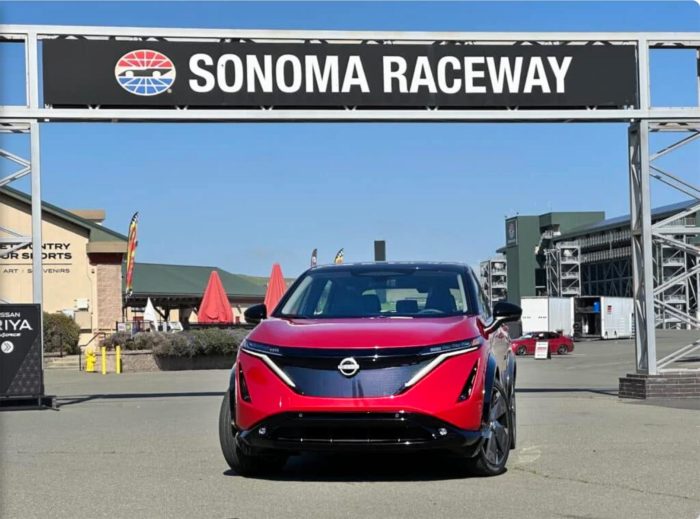
2023 Nissan Ariya e-4ORCE: Pricing
Ariya comes in at a base of $43,190 with the Engage package and FWD, jumping to $47,190 for better-equipped options. Add $1,335 to all these numbers for delivery fees.
Going with the AWD e-4ORCE system bumps you up as high as $60,190 with the nearly all-in Platinum package. The e-4ORCE packages, as a group, tend to be slightly more affordable than a Mustang Mach-E, especially when you consider the included features, such as a head-up display. On the other side, Ariya comes in a bit higher than similar Hyundai Ioniq 5 and Volkswagen ID.4 models.
One disadvantage — depending upon which products you compare — is that Ariya, imported from Japan, no longer qualifies for up to $7,500 in federal tax credits due to the Inflation Reduction Act.
For some, that might be a dealbreaker. But, that’s too bad. It took far longer than it should have to get the 2023 Nissan Ariya to market. And with the e-4ORCE system, the electric crossover really shows its capabilities. It’s pleasant to the eye, comfortable and roomy, offers plenty of features, and delivers solid range and performance.
